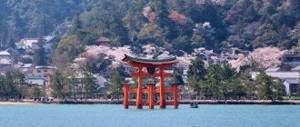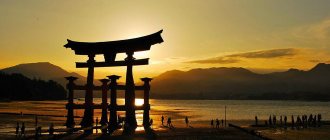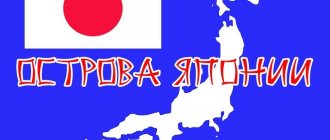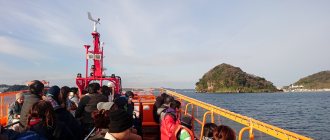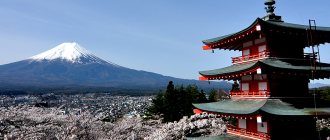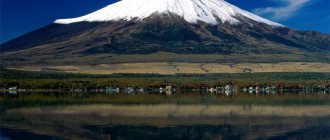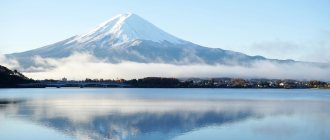Shikoku (Japanese 四国, “four regions”, in the old Russian spelling Shikoku, Shikoku, Shi-Koku) is the smallest island in terms of area and population of the four largest Japanese islands, as well as one of the regions of Japan.
The word "Shikoku" has a double meaning. In a narrow sense, it refers only to the island of Shikoku. In a broad sense, the Shikoku region (四国地方 (Japanese: しこくちほう ɕi̥koku̥ t͡ɕihoː)), which includes, in addition to Shikoku Island itself, neighboring small islands. In ancient times, the Shikoku region was part of the South Sea Region.
Shikoku is connected to the island of Honshu by three bridge systems.
Shikoku
This small island has many beautiful cities. The largest city on the island, Matsuyama, has many attractions and holy/religious sites. Shikoku is also a great place for hiking, partly because the infrastructure on the island is ideal for it.
If you translate Shikoku literally, there are "four countries" (shi for "four" and koku for "country"), which is derived from the four prefectures (municipality/province) on the island, namely Ehime, Kagawa, Kochi, and Tokushima. The entire island covers an area of only 18,292 km², which is significantly smaller than other islands. Partly for this reason, only about 4.2 million people live here. The island has a subtropical climate with warm summers and very mild winters. Therefore, the best time to travel to Shikoku is spring or autumn.
O Shikoku: Island of Enlightenment
Shikoku is seen in Japan as an island of spirituality and enlightenment. This is because the island is the birthplace of the famous Kukai (空海 Ku:kai, “sea of emptiness”) (774–835), a major religious, cultural and social figure of Heian era Japan. Founder of the Shingon school of Buddhism.
The Shikoku Pilgrimage Route, also called O-Shikoku, is one of the few circuit pilgrimages in the world. It includes 88 official holy temples and many other holy sites where the Zen master and Buddhist Kobadaishi are believed to have studied and spent time in the 9th century.
If you want to go the full pilgrim's route, get ready for a wonderful 1,300-kilometer excursion around the island. Imagine yourself hiking among Shikoku's lush nature and countless opportunities to interact with the locals. Perhaps the best way to experience Japan in all its authenticity.
Fugu Restaurants
Perhaps, given its historical background in Japanese gastronomy, fugu fish is the strangest food of the islands. Pufferfish are known to be poisonous. So much so that the tiniest dose of poison can color the evening with amazing sensations and wonderful euphoria, and a slightly larger dose will send the gourmet to his forefathers, and together with the cook, who, according to tradition, must make himself hara-kiri if the client gave his soul to God while eating fugu fish. Now everything is much more prosaic, pufferfish are grown on farms where they are not allowed to eat any bottom debris that settles in the silt and turns into toxic molecules of tetrodotoxin poison in the internal organs of the pufferfish.
There are several fugu restaurants in Takamatsu; they serve exclusively fugu - fresh in the form of sashimi - fugusashi, boiled fugu-zosui, deep-fried and dozens of other options, but be that as it may, to be honest it is not tasty. To cut fugu, the cook needs to obtain a special license. You can try Japanese “Gourmet Roulette” in one of the Takamatsu restaurants. However, you still bring the fugu sashimi with chopsticks to your mouth with a trembling hand and scold yourself for the fact that some adventures can, in theory, end very badly. And yes, there is no antidote. I recommend the nerve-wracking restaurant Hyakutora.
- Orange fact Puffer fish can swim tail first. If the puffer is frightened, it takes the form of a ball with sharp spines. Pufferfish venom is 1200 times more dangerous than potassium cyanide. The lethal dose is only 1 milligram, so the poison of one puffer fish can kill 40 people.
Cities in Shikoku
Shikoku doesn't have as many big cities as Honshu. However, this does not mean that the cities in Shikoku cannot be very nice. We especially recommend Matsuyama, Kochi, Takamatsu and Tokushima. So don't miss them on your trip to this beautiful, untouched island!
Matsuyama
Matsuyama
Matsuyama is the capital of the island and also the capital of Ehime Prefecture. The city is best known for its charming Matsuyama Castle (松山城, Matsuyamajō), which sits on a hill in the center of the city, and from the famous 1906 Japanese book Botchan by writer Natsume Soseki. Moreover, not far from the city is one of the oldest Japanese hot spring resorts, namely Dugo Onsen. On the outskirts of Matsuyama there are also several small provincial towns such as Uchiko and Ozu, which have seen fewer tourists and remain in untouched patriarchal beauty.
Kochi
Kochi is the largest city in the south of the island. Since the city is located in the south of Shikoku, it has a unique atmosphere and culture. The town is small, quiet and has a cozy, "casual" atmosphere. In the center of the city you will find a large castle called Kochi Castle (高知城, Kōchijō). Just outside the city is Shinshoji Temple (津照寺), which is often visited by pilgrims on the 88th temple route.
Takamatsu
Takamatsu is the capital of Japan's smallest prefecture, Kagawa Prefecture. The city's port was the only way to get to Shikoku. There is a lot of work in the city right now. There are countless museums about art and architecture, and just outside the city you'll find the famous Ritsurin Koen Gardens. Possibly the most beautiful garden in all of Japan.
Tokushima
Tokushima is a city best known for the dance festival that is held here every year. In August, the Awa Odori festival takes place here. The festival revolves around the so-called "Dance of Fools".
Tens of thousands of people come to Tokushima to participate in this dance, a tradition that can be traced back to the 17th century. There is also an interesting and educational museum about the festival.
Ritsurin Park
The 75-hectare gardening farm was established in Takamatsu more than 350 years ago. Everything is arranged and planted in strict accordance with the instructions of Japanese gardens, so that at every new turn, from every curved bridge, a new landscape appears before your eyes and the angle of view changes. The best time to accept the idea of landscape designers is autumn, however, cherry blossoms also bloom in spring. Surely the name of the founder of the garden from the Ikomo clan will not tell you anything, nor will a detailed listing of the metrics of the family from the Matsudairo dynasty, which later looked after the Ritsurin park.
It took a hundred years for the gardens, 13 hills and Mount Hirai - the Mount of the Immortals, symbolizing Fuji - to look perfect. The Japanese were terrible perfectionists even three hundred years ago. Therefore, visitors should also ideally walk around Ritsurin, slowly, with stops, sitting on benches, renting a boat. With an obligatory tea ceremony in a house near the Kikugetsu-tei pond - “a gazebo for enjoying the beauty of the full moon in autumn.” You definitely need to get to the other side of the six ponds, where falcons hunt on a fine day.
- Orange fact In a Japanese traditional garden, Japanese sakura, maples and pine trees must certainly grow. Be sure to have a pond with koi carp, a tea house, a rock garden, a gazebo with wisteria and lanterns, into which fish oil used to be poured, a wick inserted and set on fire. The water should not only be silent and silent, like a pond, but also speak two languages - a stream and a waterfall.
You need to admire the landscapes meaningfully - the heart should rest in a Japanese garden. If you look at the Mountain of the Immortals, then you yourself are also approaching immortality. Studying the details on Turtle Island, you think about longevity. If you come across koi carp, which can sooner or later, according to legend, turn into a dragon, thoughts about fortitude should appear. Finally, you need to go to the bonsai garden; Kagawa Prefecture is famous for them, and especially for dwarf pines. Many trees are more than three hundred years old.
- Opening hours of Ritsurin Koen Prak: January: from 7:00 to 17:00 February: from 7:00 to 17:30 March: from 6:30 to 18:00 April and May: from 5:30 to 18:30 June -August: from 5:30 to 19:00 September from 5:30 to 18:30 October: from 6:00 to 17:30 November: from 6:30 to 17:00 December: from 7:00 to 17:30
- Ticket price: 400 yen
- How to get there: From JR Takamatsu Station, take the commuter train to Ritsurinkoen-Kitaguchi Station (5 minutes). 5 minutes walk from the station.
Nature in Shikoku
Shikoku, like the rest of Japan, is very mountainous. This makes this island very suitable for long walks in nature. During these walks you will discover beautiful nature, small authentic Japanese villages, and friendly residents. The 88 Temples Route pilgrimage is also recommended, even if you are not a pilgrim. You don't need to worry about the weather on the island: the climate is pleasant all year round, even in winter.
Route 88 temples
The 88 Temples Route is a pilgrimage that passes through all 88 Buddhist temples in Shikoku. You will follow in the footsteps of Zen master Kobo Diasha, who made this journey to gain insight. The trip is at least 1300 kilometers long. For the Japanese, this is a trip they must take once in their lifetime. Thousands of Japanese and foreigners make this trip every year.
Beaches
In addition to the 88 Temple Route, Shikoku is also known for its beautiful beaches. Only on the island of Okinawa can you find better beaches. On Shikoku's beaches you can relax and swim, as well as surf, kayak and dive. Beaches are not difficult to find as they are scattered throughout the island.
Aya Valley
Ayia Valley is the place to go if you are a true nature lover. This valley contains deep gorges, vast forests and ancient rope bridges. Here you will find the most beautiful hiking trails in all of Japan! You can also go rafting and kayaking on wild rivers such as Simanto.
History of Shikoku
Like Hokkaido, Shikoku remained closed from the rest of Japan for a long time. Previously, in the Middle Ages, the island was divided into four regions. They all had and still have their own mini-culture and customs . There are also many differences between these regions geographically. For example, the northern regions are developing somewhat better. This is mainly because they are easier to reach from the large island of Honshu. To reach the southern regions, one first had to go through the mountains. For this reason, residents of the southern regions are always viewed as backward, tough and independent people.
Shikoku was previously closed off from the rest of Japan. But in 1988, everything changed, the Japanese began to invest money in infrastructure, building bridges and roads to other islands of Japan , making the islands part of Japan. This has led to economic growth and improved welfare as well as accessibility for tourists.
Economy
The Inland Sea coast, which covers the island from the north, is a fishing and industrial center and a busy communications channel. Eleven prefectures border the Inland Sea. Industrial activity and the reclamation of new land from the sea have disturbed the coastline, polluted the water and hampered fishing. Industries and sectors with a long tradition: traditional crafts, agriculture, livestock, food processing, agricultural products, fisheries, seafood, aquaculture, forestry, wood, pulp and paper, shipbuilding, textiles, metal products, transport equipment, non-ferrous metals, chemicals, oil refining.
New industries: electronics, LED products, nanotechnology, biotechnology. In the southern part, residents are engaged in growing citrus fruits, harvesting and fishing. The growing season here is up to 260 days.
Shikoku's overall gross domestic product (GDP) for major industries is 5.6% of the national total, which is higher than average compared to other regions of Japan. The value of goods produced is about 80 million US dollars, or 3.1% of the country's total.
The Second World War
Like other Japanese islands, Shikoku also suffered greatly from the events of World War II. Especially at the end of the war, in 1945, Shikoku was attacked daily by American bombers. The targets were civilian cities, infrastructure, industry and military installations. Almost all the cities on the island were completely destroyed and were rebuilt by the hardworking Japanese after the war. But even now you can see traces of this barbarism in the cities and landscape of the island.
Housing
Like other islands in Japan, Shikoku has no shortage of accommodation options. You will find many hotels and hostels in the cities. There are also many places where you can spend the night in remote areas, such as in the temples themselves or in the homes of ordinary people.
Live in a Buddhist Temple.
Southern Islands
The Southern Islands of Japan usually include the Ryukyu Islands, located to the southwest of the main part of the country, the Bonin Islands, located in the Pacific Ocean, at a distance of 1000 km from Tokyo, and the most remote island of Minamitori.
The Ryukyu Islands are a group of 98 islands in the East China Sea, stretching 1,200 kilometers from Kyushu to Taiwan. The total number of inhabitants is 1.6 million people, the total area is 4700 square meters. km. 90% of the islands' inhabitants live on the largest island, Okinawa. Currently, only 47 islands have a permanent population. The most developed sectors of the economy are fishing, agriculture and tourism.
The Bonin Islands are a group of 41 islands located south of Tokyo between the Mariana Islands and Japan. The total population is about 2,500 people, the total area does not exceed 104 square kilometers.
Minamitori is the easternmost island that belonged to Japan. It is located 1848 km southeast of Tokyo and 1267 km east of the nearest Japanese island. Minamitori has an area of 1.2 square kilometers and has no permanent population. Despite this, the island is of extreme strategic importance, allowing Japan to claim 428,875 km² in surrounding waters.
Facts about Shikoku
- It wasn't until 1988 that the first bridge was built between Shikoku and another island, in this case Honshu. Before this, the island was only accessible by ferry.
- The total length of all bridges between Shikoku and other islands is at least 173 kilometers.
- Every year, at least 200,000 people make the pilgrimage along the 1,300 km route of 88 temples.
- Shikoku is also a dog breed. As you probably guessed, it takes its name from this island.
Views: 3,667
Share link:
- Tweet
- Share posts on Tumblr
- Telegram
- More
- by email
- Seal
Administrative division[ | ]
The Shikoku region includes four prefectures:
| № | Prefecture | Administrative center | Population, people (2010) | Area, km² | Density, people/km² |
| 1 | Tokushima | Tokushima | 784 493 | 4 146,59 | 189,19 |
| 2 | Kagawa | Takamatsu | 995 465 | 1 876,52 | 530,48 |
| 3 | Ehime | Matsuyama | 1 430 086 | 5 677,95 | 251,87 |
| 4 | Kochi | Kochi | 771 473 | 7 105,15 | 108,58 |
| Total | 3 981 517 | 18 806,21 | 211,71 |
